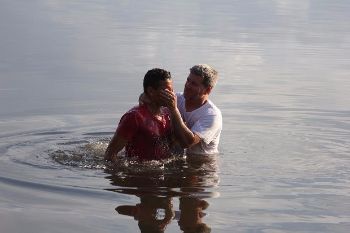
Thirty-three years ago, no one would have dreamed that Hardin Baptist Church would be what it is today.
When the church extended a call to Pastor Ricky Cunningham, who was in his early 20s at the time, the congregation averaged about 60 people in attendance and met in a building that would accommodate 120. Today, the church has relocated to a more visible location and ministers to about 1,250 people each Sunday.
Recently, Pastor Cunningham shared what he felt the Lord used to grow the church in this unusual degree. His answers are helpful to others who are laboring and praying to see a church become more effective in its mission.
The people were willing to follow their pastor. When he came as pastor, Cunningham said, there was a sense of desperation among church members. They knew they were stagnant and needed to do something to move forward, but they did not know what.
“I like to say the church was hungry to do what God wanted them to do as a church because they recognized that at their current pace, if they didn’t change things, their future was not good,” he said.
For a church to move forward, there must be an agreement between pastor and congregation that the status quo is no longer working and something has to change. Cunningham shared, “They told me that if I would lead them, they would follow—and, buddy, they did.”
They remodeled their sanctuary. The old facility—the one they were using 33 years ago—needed repair and updating. “A church building says something about the way you feel about the things of God,” Cunningham asserted.
The way a church takes care of its facility communicates to outsiders, he observed. Churches that fix items that need to be repaired, work hard at cleanliness, and keep the lawn and parking lot neat make a statement to those who pass by their building. It is often the case that a church that has experienced turn-around did exactly what Hardin Baptist did.
They started a second service. While the church agreed that a second service was needed due to new people coming, the service itself was considered a failure. Cunningham explained, “Hardin Baptist was a family church. All the young people started coming to the early service, which was negatively affecting its family culture.”
The church voted to return to one service, and instead built a building that would accommodate the growth God was sending. After Cunningham had been there four years, the church constructed a sanctuary that would seat 330 people.
“We thought that would hold us until Jesus came,” he said. It didn’t.
The church could not afford to hire a contractor, so they borrowed money for materials and used skilled laborers in the church. They have since relocated about a mile from their original site and built a facility to accommodate 675 people in worship. They now have three services and average between 1,200 and 1,300 people.
“They had such a good experience building the other building with volunteer labor that they built this one the same way,” Cunningham said.
They became intentionally evangelistic. Cunningham went through “Continued Witness Training” because he knew how to share his faith, but he did not have a good plan for equipping others to witness.
As a result of the CWT process, church leaders began equipping people to the point that when Hardin reached 200 in church, 100 of them were equipped through CWT.
“The first 13 weeks we went out sharing our faith, we had 13 people receive Christ, and they all got baptized at another church,” he recalled.
This did not discourage the folks at Hardin Baptist, as they saw personal evangelism as Kingdom work. “Training those people to share gave us a culture of intentional evangelism, winning people to Christ,” Cunningham noted.
The culture of the church became so evangelistic that when it came time to do a church directory, those in charge would not let the pastor be photographed sitting behind a desk. Instead, they had him go and knock on someone’s door because that was closer to the nature of his leadership.
The pastor focused on preaching. For most of the 33 years that he has been at Hardin, Cunningham has worked bi-vocationally as a farmer. He and his family farm several hundred acres of land in West Kentucky. As a pastor, he puts his ministry efforts into the preparation and practice of preaching.
“When I came to Hardin, the people decided that we were going to preach ‘The Book,’” he said. “We decided that I would preach through books of the Bible and deal biblically with every topic that came up. They remain committed to the Bible.”
While every church will not follow the path taken by Hardin Baptist Church. There are experiences here that others can learn from. They have made a commitment to the gospel, to the community and to reach the lost, and the Lord has honored their commitment.
“Thirty-three years ago, Hardin was famous for catfish and a local restaurant had a particularly strong reputation. In my trial sermon, I said that I hoped one day that Hardin was more known for the gospel than for catfish,” he recalled.
The restaurant has since relocate to a neighboring town, but the gospel is still being proclaimed loud and clear. (WR)
Todd Gray